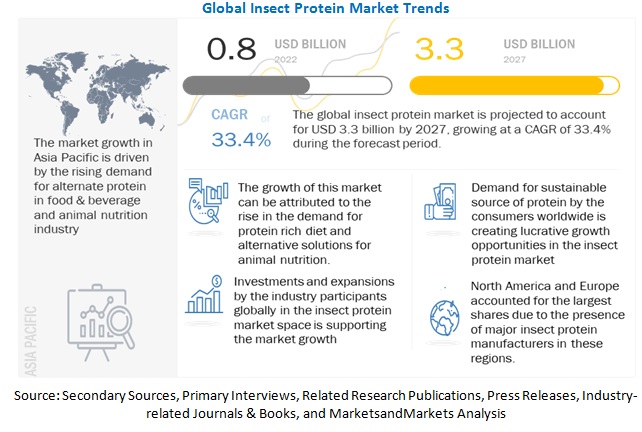The insect protein market is estimated to be valued at USD 144 million in 2019 and is projected to reach USD 1,336 million by 2025, recording a CAGR of 45.0% during the forecast period. The increasing need for protein as nutrition and increasing investments in research & development are some of the factors driving the growth of the insect protein market.
Insect protein is a high-quality protein that is extracted from various types of insects and used in various application such as food, feed, and pharmaceuticals & cosmetics. The nutritional benefits of insect protein, in comparison with animal-based and plant-based protein, is responsible for the wide adoption of insect protein in the North American and European markets. An evidence to this assertion would be the use of crickets in food application due to their high protein, and the experimentation around the application of varied insects or major feed application. Moreover, the declining production of fishmeal, its fluctuating prices, and the pressure on food security have led to an increasing need for a protein substitute, which is fulfilled by these insects. These factors are projected to drive market growth during the forecast period.
Request for Customization@
https://www.marketsandmarkets.com/requestsampleNew.asp?id=150067243
Insect protein has gained traction from various firms in the past five years. Multiple capital investors have been willing to invest in emerging insect protein manufacturers. This is due to the rising awareness about the benefits of insect protein and also the necessity to develop alternative sources of protein to meet the rising global demand. Companies such as Cargill (US) and PepsiCo (US) are directing their investment toward this market, which has raised the credibility of insect protein products. In 2019, Cargill (US) and InnovaFeed (France) entered into a strategic partnership to bring sustainable and innovative feed options to the animal nutrition industry. Through the partnership, Cargill (US) and InnovaFeed (France) would collaborate to market fish feed jointly, which includes insect protein. The partnership would also enable both the partners to support the growth of sustainable aquaculture. Established companies have also been investing in start-ups to provide them monetary support for research & development, expansion of their production facilities, and marketing strategies related to brand awareness. In 2017, PepsiCo (US) entered the insect protein market through an investment in a start-up company called Jimini’s (UK), a producer of insect-based food products in Europe.

Government initiatives and support encourage companies to invest in insect farming or insect protein-based products and encourage people to include insects in their diets. For instance, in July 2015, the USDA funded a project that focused on insect farming for human food, concentrating on improving the efficiency and lowering costs in farming crickets. The project was led by a Georgia-based company, All Things Bugs LLC, which studied methods to increase automation in raising crickets. The project particularly focused on harvesting, watering, and feed formulations, with end goals to enhance cricket growth while lowering the cost of raising them, which, in turn, can decrease the price of cricket powder. In June 2017, Protix, a Netherlands-based company, raised USD 50.5 million in equity and debt funding in which the major investors were Brabant Development Agency (BOM), Rabobank, and Aqua-Spark, along with other private investors who had participated in the investment.
In response, as general awareness and concern for the loss of tropical forest ecosystems and biodiversity, the government of Papua New Guinea deemed insects a national resource and a candidate for economic development. This policy resulted in the establishment of the Insect Farming and Trading Agency (IFTA) in 1978, which focused on creating income-producing opportunities for villages through non-destructive extraction of forest resources while at the same time creating an incentive for preservation. Thus, with proper regulations and government support, the number of insect farms and protein ingredient manufacturers focusing on insect protein-based food and feed is projected to increase during the forecast period.
Speak to our analyst for a discussion on the above findings@
https://www.marketsandmarkets.com/speaktoanalystNew.asp?id=150067243